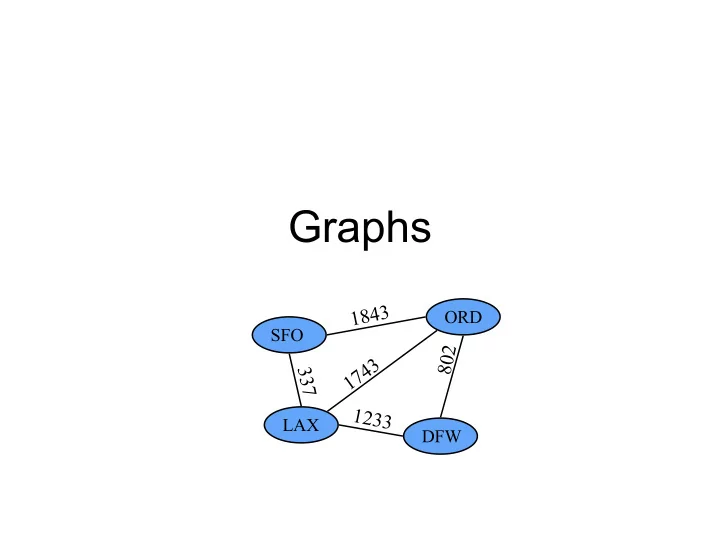

Graphs 3 4 8 1 ORD SFO 802 1743 337 1 2 3 3 LAX DFW
Outline / Reading Graphs (6.1) • Definition • Applications • Terminology • Properties • ADT Data structures for graphs (6.2) • Edge list structure • Adjacency list structure • Adjacency matrix structure Graphs 2
Graph A graph is a pair ( V, E ), where • V is a set of nodes, called vertices • E is a collection of pairs of vertices, called edges • Vertices and edges are positions and store elements Example: • A vertex represents an airport and stores the three-letter airport code • An edge represents a flight route between two airports and stores the mileage of the route 849 PVD 3 4 8 1 ORD 142 SFO 802 1743 LGA 337 1387 1 2555 0 HNL 9 1 2 9 3 3 LAX 1120 DFW MIA Graphs 3
Edge Types Directed edge Directed graph • ordered pair of vertices ( u , v ) • all the edges are directed • first vertex u is the origin • e.g., flight network • second vertex v is the destination • e.g., a flight flight ORD PVD AA 1206 Undirected edge Undirected graph • unordered pair of vertices ( u , v ) • all the edges are undirected • e.g., a flight route • e.g., route network 849 ORD PVD miles Graphs 4
Applications • Electronic circuits cslab1a cslab1b – Printed circuit board math.brown.edu – Integrated circuit • Transportation networks cs.brown.edu – Highway network – Flight network brown.edu qwest.net • Computer networks att.net – Local area network – Internet – Web cox.net John Paul • Databases David – Entity-relationship diagram Graphs 5
Terminology • End vertices (or endpoints) of an edge – U and V are the endpoints of a • Edges incident on a vertex V – a , d , and b are incident on V a b h j • Adjacent vertices d U X Z – U and V are adjacent c e i • Degree of a vertex W g – X has degree 5 f • Parallel edges Y – h and i are parallel edges • Self-loop – j is a self-loop Graphs 6
Terminology (cont.) Path • sequence of alternating vertices and edges • begins with a vertex • ends with a vertex V • each edge is preceded and followed by its b a P 1 endpoints d U X Z P 2 h Simple path c e • path such that all its vertices and edges are distinct W g f Examples Y • P 1 =(V,b,X,h,Z) is a simple path • P 2 =(U,c,W,e,X,g,Y,f,W,d,V) is a path that is not simple Graphs 7
Terminology (cont.) Cycle • circular sequence of alternating vertices and edges • each edge is preceded and followed by its V endpoints a b d U X Z Simple cycle C 2 h • cycle such that all its vertices and edges are e C 1 c distinct W g Examples f Y C 1 =(V,b,X,g,Y,f,W,c,U,a, ¿ ) is a simple cycle • C 2 =(U,c,W,e,X,g,Y,f,W,d,V,a, ¿ ) is a cycle that is • not simple Graphs 8
Properties Property 1. In an undirected graph Notation S v deg( v ) = 2 m n number of vertices Proof: each edge is counted twice m number of edges deg( v ) degree of vertex v Property 2. In an undirected graph with no self- loops and no multiple edges m £ n ( n - 1) / 2 Proof: each vertex has degree at most ( n - 1) What is the bound for a directed graph? Ex: n = = 4; m = = 6; deg( v ) = 3 Graphs 9
Main Methods of the Graph ADT Vertices and edges Update methods • are positions • insertVertex(o) • store elements • insertEdge(v, w, o) • insertDirectedEdge(v, w, o) Accessor methods • removeVertex(v) • aVertex() • removeEdge(e) • incidentEdges(v) • endVertices(e) Generic methods • isDirected(e) • numVertices() • origin(e) • numEdges() • destination(e) • vertices() • opposite(v, e) • edges() • areAdjacent(v, w) Graphs 10
Data Structures Structures to represent a graph: 1. Edge List 2. Adjacency List 3. Adjacency Matrix Graphs 11
Edge List Structure A container of edge objects, where each edge object references the origin and destination vertex object Graphs 12
Adjacency List Structure An edge list structure, where additionally each vertex object v references an incidence container which stores references to the edges incident on v . Graphs 13
Adjacency Matrix Structure A 2D array of all vertex pairs, where cell A[ u , v ] stores edge e incident on vertices u,v if such an edge exists. Graphs 14
Asymptotic Performance n vertices, m edges Edge Adjacency Adjacency no parallel edges List List Matrix no self-loops Bounds are “ big-Oh ” n + m n + m Space n 2 incidentEdges( v ) m deg( v ) n areAdjacent ( v, w ) m min(deg( v ), deg( w )) 1 insertVertex( o ) 1 1 n 2 insertEdge( v, w, o ) 1 1 1 removeVertex( v ) m deg( v ) n 2 removeEdge( e ) 1 1 1 Graphs 15
Recommend
More recommend